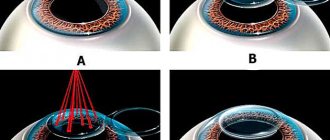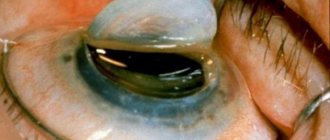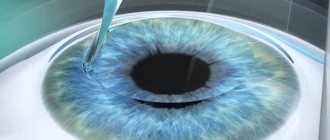In this article we will examine in detail the operation to correct defects in the eye area - laser blepharoplasty. You will learn how it differs from the classic one, what its advantages and types are. What problems does it help fight, how is it done and possible complications after it is performed. And also, reviews from patients and opinions of surgeons. We will also show the results in before and after photos.
Laser blepharoplasty
Laser vs scalpel: 10 important advantages
- There is no need to go to the hospital.
- Laser blepharoplasty takes less time.
- Although it is traditionally done under general anesthesia, in some cases local anesthesia can be used.
- The laser beam is thinner than steel and leaves much smaller cuts.
- The surgeon sets the depth of beam penetration using a computer, and therefore acts with precision that is difficult to achieve with a scalpel even for the most experienced specialist.
- Simultaneously with excision of tissue, the laser cauterizes it, which helps reduce blood loss and reduces the risk of infection in the wounds.
- Bruising and swelling - natural consequences of surgery - are less pronounced after laser blepharoplasty, and the healing process itself is faster.
- Postoperative scars are almost invisible. They are definitely inferior to the marks from the intervention of a surgical scalpel.
- The result of the operation is in no way inferior to conventional plastic surgery, and sometimes even surpasses it.
- The laser beam activates regenerative processes in tissues, causes cells to actively regenerate and promotes skin rejuvenation.
There is one noticeable disadvantage of laser blepharoplasty – a higher price.
What laser is used for blepharoplasty
Real laser blepharoplasty - that is, plastic surgery - can only be done using a CO2 laser. Its beam is capable of penetrating into the deep layers of the epithelium, making neat cuts, immediately sealing the damaged areas, and efficiently solving the problems of drooping eyelids, wrinkles and other cosmetic troubles.
The operation is performed using a CO2 laser
The erbium laser is not capable of this, however, it is also used in the care of the periorbital area of the face. It acts extremely delicately: it does not leave burns, does not require long-term rehabilitation, but it efficiently evaporates the stratum corneum from the surface of the skin and triggers regenerative processes in cells, which helps their renewal. Using an erbium laser, skin resurfacing is performed, after which the eyelids look more toned and youthful. However, in terms of the degree of impact and, therefore, the duration of the effect, it cannot be compared with CO2.
Erbium laser is often used after CO2 to smooth out the smallest marks from plastic surgery and speed up healing.
Laser resurfacing
How is non-surgical blepharoplasty performed?
The laser blepharoplasty procedure is carried out in several stages:
Stage 1: Skin rejuvenation from inside the eyelids (Fotona Smooth technology) The eyes are protected with special intraocular caps using an anesthetic gel. The mucous membranes of the lower and upper eyelids (conjunctiva) are treated with a photon ER:YAG laser in the fractional Smooth - coagulation (heating) mode.
The effect of laser radiation precisely through the conjunctival mucosa, taking into account the chromophore, allows you to increase the temperature of deep-lying tissues without absolutely damaging the mucosa!!! and those structures to which heat will be directly transferred. At the same time, the volume of adipose tissue in the conjunctival sac is reduced, deep structures are rejuvenated by stimulating collagen renewal processes in all layers of eyelid skin.
Stage 2: Deep rejuvenation of the skin around the eyes and upper third of the face (Frac3 technology) Stage of deep dermal laser treatment on the area around the eyes and the entire middle third of the face, including the skin of the forehead. This stage of the procedure is performed using a neodymium laser (Fotona Nd:YAG). The integrity of the skin is not compromised. The purpose of this stage of the procedure is to launch the processes of neocollagenogenesis, reconstruction of tissues of the upper third of the face, elimination of venous stagnation, pigmentation, improvement of turgor and skin tone.
Stage 3: Revitalization of facial skin at all levels (Piano technology) Neodymium laser (Nd:YAG) in Piano mode evenly and painlessly heats not only the middle but also the deep layers of the dermis. This effect produces a powerful effect of revitalizing, toning and tightening tissue.
Stage 4: Laser skin resurfacing in Smooth mode. Erbium laser (ER:YAG) is applied to the skin of the upper and lower eyelids and the entire middle third of the face, as well as the skin of the forehead (to tighten the upper eyelid). Thus, powerful lifting is ensured, skin turgor and tone are restored, wrinkles are smoothed out, and pigmentation is eliminated.
Additional 5th stage: Fractional laser rejuvenation The skin of the lower and upper eyelids is treated with fractional ER:YAG laser beams in ablation (evaporation) mode, damaging the skin surface in order to reduce the skin flap, noticeably tighten sagging eyelids and significantly rejuvenate the tissue.
Types of laser blepharoplasty
The type of surgery depends on what part of the eyelids will be corrected and what technique the surgeon will use.
By venue
Depending on what problem needs to be solved, the upcoming operation can be divided into:
- Blepharoplasty of the upper eyelids. Excess skin is excised, the overhanging upper eyelid is lifted into place, and sagging is eliminated.
- Blepharoplasty of the lower eyelids. Bags, swelling, and fatty hernias under the eyes are removed.
- Circular blepharoplasty. This method of surgical intervention combines the first and second options and allows you to tidy up the skin in the entire periorbital area.
- Changing the shape of the eyes. Making necessary adjustments to the appearance of patients who are dissatisfied with the shape of their eyes.
- Canthopexy. Aimed at tightening the drooping corners of the eyes, returning openness and youth to the look.
By technique
Blepharoplasty techniques are constantly being developed and improved to meet two main requirements: to be safe for the patient and, if possible, not to leave noticeable scars. The surgeon’s choice of a specific technique depends on which area of the periorbital region needs correction.
Types of techniques
- The suture is placed along the edge of the lower eyelid at the eyelash line (lower eyelid blepharoplasty).
- The suture is hidden in the deep skin fold of the upper eyelid above the eye (upper eyelid blepharoplasty).
- An incision is made on the inside of the lower eyelid, after which excess muscle tissue and fat are removed. The technique is called transconjunctival or sutureless laser blevaroplasty and makes it possible to tighten sagging skin and remove bags and hernias under the eyes without leaving a trace. But it cannot cope with clearly visible age-related ptosis (tissue drooping). In such cases, more extensive intervention is required.
If the shape of the eye needs to be reshaped, the surgeon may use incisions on both the top and bottom of the eyelids.
Comparison with other rejuvenation methods
To tighten the skin of the eyelids and eliminate wrinkles, you can use non-surgical methods rather than surgical or laser blepharoplasty.
These include:
- Botulinum toxin injections. With their help you can eliminate small expression wrinkles.
- Mesotherapy . Moisturizes the skin and increases its elasticity.
- Thermolifting. The procedure eliminates old protein molecules, which forces the body to regenerate new ones. Due to this, a rejuvenating effect is manifested.
- Ultrasound lifting. Seals and strengthens collagen fibers.
- Rejuvenation with laser. It evaporates layers of skin, activating regeneration processes.
Unfortunately, the possibilities of non-surgical methods are limited. And then, to preserve the youth of the skin around the eyes, you have to resort to blepharoplasty. However, in addition to the laser method, there are other ways to restore the youth of the face.
Blepharoplasty with a scalpel
Blepharoplasty with a scalpel is the progenitor of the laser method. The main difference is the greater dependence of success on the skills of the surgeon.
- In subciliary blepharoplasty, an incision is made along the natural fold of the eyelid skin.
- Transconjunctival blepharoplasty is prescribed only to those under 30 years of age. In the process, the skin is cut into the mucous membrane of the lower eyelids. This method is usually supplemented with laser resurfacing to make the rejuvenation effect more pronounced.
The slightest mistake by a plastic surgeon can have significant consequences that cannot be eliminated without another operation.
Blepharoplasty with a scalpel has more pronounced consequences compared to laser: swelling, bruising and suture stripes. Skin tone recovers more slowly after surgery.
Depending on the type of work, the surgeon acts differently.
- In lower eyelid blepharoplasty, the surgical suture is passed along the edge of the eyelash growth.
- In upper eyelid surgery, an incision is made in a fold of skin to remove excess skin.
- When changing the shape of the eyes, the surgeon acts according to pre-designed contours. In this case, he can use incisions on both the upper and lower eyelids.
The price for blepharoplasty with a scalpel is lower than when using a laser.
Fractional thermolysis
This procedure is only partially similar to blephaloplasty: laser thermolysis affects certain areas of the skin. Thanks to it, you can get rid of facial wrinkles and bags under the eyes.
However, fractional thermolysis will not be able to eliminate ptosis of the upper eyelid or remove a fatty hernia. In essence, it is laser skin resurfacing, thanks to which you can get rid of minor imperfections.
The price for this procedure is usually slightly lower than laser blepharoplasty.
Indications for surgery
Laser blepharoplasty successfully copes with such cosmetic imperfections in appearance as:
- eyelid ptosis;
- bags and hernias;
- drooping corners of the eyes;
- lack of symmetry of facial features in the middle third;
- excess tissue in the eye area, “swollen” eyelids;
- wrinkles of varying severity;
- general sagging tissue, and this applies to both skin and muscles;
- client's dissatisfaction with the shape of his eyes.
Medical indications include:
- turning of the eyelids;
- various mechanical damage to the skin and muscles in this area;
- eyeballs protruding strongly forward.
When should you not do it?
However, laser blepharoplasty cannot always be performed. It has a number of contraindications, in the presence of which the doctor will be forced to refuse the patient to perform the operation. These include:
- some diseases of the endocrine system;
- a number of chronic diseases in the acute phase;
- inflammatory or infectious processes in the eye area;
- hemophilia;
- tumors of both malignant and benign types;
- HIV;
- increased level of intraocular pressure;
- excessive sensitivity to laser exposure.
Are there any contraindications
Contraindications
Despite the fact that blepharoplasty is one of the minimally invasive operations and is considered uncomplicated, there are categories of patients who will have to refuse it. A clear contraindication would be:
- anemia;
- blood clotting problems;
- some diseases of the eyes (keratitis), muscle tissue (myopathy) or skin of the eyelids (blepharitis);
- pathology of the thymus gland;
- oncology;
- arterial hypertension and increased intracranial pressure.
Relative contraindications:
- inflammation of the skin of the eyelids, barley, etc.;
- colds or viral diseases;
- recovery period after another surgical intervention;
- menstruation.
Some diseases serve as a conditional contraindication. For example, diabetes mellitus puts a “veto” on blepharoplasty, but if the blood sugar level can be stabilized with a set of therapeutic measures, permission for the operation can be obtained.
How is laser blepharoplasty done?
Each case of blepharoplasty is unique in its own way. It is difficult to predict how surgery on the eyelids of a particular person will occur: here you need to take into account the nuances of the problem, the physiological characteristics of the body, and the experience of the surgeon. We will talk about the general stages of the operation using transconjunctival laser blepharoplasty as an example.
In blepharoplasty, the main thing is an experienced surgeon and thorough preparation.
Preparation
It all starts with a consultation with a specialist who will listen to the complaints of the client (or client, blepharoplasty in men is very common today), conduct an initial examination and collect data on the person’s health.
If at this stage no contraindications to the operation are identified, the patient will be sent for tests:
- general and biochemical blood test;
- analysis of glucose and electrolytes;
- coagulogram;
- analysis for HIV, syphilis, hepatitis B and C;
- general urine analysis;
- In addition, you will need to find out your blood type and Rh factor.
When the doctor has a complete picture of the client’s health condition, a final decision will be made and the date of the operation will be set.
Stages of implementation
- Markings are applied to the cleansed face, indicating the main areas of action. This is done in a vertical position so that tissue displacement does not distort the picture.
- The patient is given an antibiotic drip and the eyeballs are covered with protective lenses. They vaguely resemble ordinary contact lenses, but are opaque.
- The face is treated with a disinfectant solution.
- The patient is put under anesthesia, and the doctor begins the operation.
- The lower eyelid is carefully pulled back with special forceps.
- Using a laser, a neat incision is made on the mucous membrane.
- Then the laser excises the excess fatty tissue and extracts it with tweezers.
- A miniature wound with the edges partially sealed by a laser beam will be sutured with self-absorbing threads. In some clinics, the lower eyelids are then treated with an erbium laser. There is usually no need to secure the tissue with bandages.
- After recovering from anesthesia, the patient will spend some time in the hospital under the supervision of doctors, but after a couple of hours, if no complications arise, he will be able to go home.
The entire operation takes about 1 hour, observation in the hospital – 1-2 hours.
Video: laser blepharoplasty (removal of bags under the eyes)
Features of rehabilitation after the procedure
Laser blepharoplasty is necessarily accompanied by a postoperative period – a rehabilitation stage. On average it lasts up to two weeks. The doctor's recommendations include:
- applying cold compresses;
- abstaining from using cosmetics for 10 days;
- position during sleep - lateral or on the back, the head should be located above the body;
- avoiding taking aspirin and medications containing it;
- limiting physical activity for 3 – 4 weeks;
- refusal to visit the bathhouse, sauna;
- limiting time spent in the sun;
- When performing transconjunctival lower eyelid surgery, it is necessary to use sunscreen.
Most popular: Does your facial skin need thermal water from the depths of the earth?
Rehabilitation period
The main task of the operated person during the recovery period is to conscientiously comply with the doctor’s requirements and not interfere with the natural healing processes of the skin.
At this time it is important:
- Protect your face from pollution.
- Protect the skin around the eyes from direct sunlight.
- Do not touch it with your hands unless absolutely necessary, and certainly do not rub it.
- Use mild cleansers, apply cold compresses or apply patches recommended by your doctor.
- Do not use decorative cosmetics for 10-14 days.
- Avoid physical activity for about 1 month.
- Do not go to the bathhouse, sauna, or swimming pool for 2 months.
- Visit a doctor to monitor the healing process. Often, one visit to the clinic is enough for this.
What is fractional laser treatment?
Lasers operate in different modes, not just scalpel mode.
The essence of the fractional mode is that the laser beam is divided into many small beams (from 100 to 1,000). When treating the eyelid area, the laser makes microscopic holes around the eyes - nanoperforations.
Light spots are holes in the skin after exposure to a fractional laser.
These laser procedures are called “laser eyelid surgery” or “non-surgical laser blepharoplasty.”
In this case, fractional eyelid blepharoplasty is not a surgical procedure. The effect occurs only on the skin. There are no incisions and usually only local anesthesia is used.
The words "plasty" and "blepharoplasty" for this procedure are used to emphasize the surgical-like effect that modern fractional lasers have on the skin around the eyes.
Complications and side effects
The words “minimally invasive surgery” do not mean that when replacing a scalpel with a laser, it will be possible to do without the standard side effects of blepharoplasty, because the facial tissues are still injured and will definitely react to it.
A common occurrence in such cases is swelling and bruising, which completely disappear in about a week. You should not be afraid of them, but if after 7-8 days the puffiness and cyanosis still make themselves felt, it is better to immediately make an appointment with a doctor.
Final healing occurs after 1-1.5 months.
Result of laser blepharoplasty of the lower eyelids: day 7, suture removal
Complications are a much more dangerous phenomenon. These include:
- infection of the wound due to non-compliance with hygiene measures;
- divergence of seams due to overly active facial expressions, strong tension or mechanical influence from the outside;
- tissue scarring, which rarely occurs after laser blepharoplasty, but still remains possible, especially if a person has a genetic predisposition to the formation of keloid scars;
- retrobulbar hematomas, leading to protrusion of the eye, its pain and immobility;
- drooping of the upper eyelid due to inept actions of the doctor;
- lagophthalmos, or the inability to close the eyelids tightly. Sometimes this phenomenon may turn out to be a common side effect of the operation, but if after a week the eyelids do not return to normal, it is time to talk about a complication.
Most likely problems can be treated with antibiotics, medications and fractional laser, but sometimes the question of repeat surgery may arise.
How long will the achieved result last?
How long a patient can enjoy a renewed reflection in the mirror depends on the state of his health in general and his skin in particular, the physiological characteristics of the body and lifestyle. The standard rules of a healthy lifestyle - prepare proper food, drink plenty of water, avoid a sedentary lifestyle, do not smoke or drink alcohol, get enough sleep - will delay the onset of negative changes.
On average, the achieved effect lasts 5-6 years, and with luck, even 10.
Cost of laser blepharoplasty
Prices for surgery can vary significantly within the same city, so there is no need to talk about exact figures here. We invite you to familiarize yourself with the average data for Moscow and St. Petersburg. The cost is indicated in rubles.
| City | Laser blepharoplasty of the upper eyelids | Laser blepharoplasty of the lower eyelids | Circular laser blepharoplasty |
| Moscow | 45 000-60 000 | 50 000-60 000 | 80 00-170 000 |
| Saint Petersburg | 23 000-45 000 | 65 000-75 000 | 50 000-80 000 |
Laser blepharoplasty procedure for the area around the eyes
In what other cases is it indicated?
- Changes in the skin associated with the aging process;
- The presence of a congenital feature associated with the racial shape of the eyes;
- Development of baggyness in the lower eyelids;
- Problem of excessive skin around the eyes;
- Asymmetry on the face related to the periocular surface.
Contraindications to the laser blepharoplasty procedure
Developed dry eye syndrome;
- Presence of diabetes mellitus;
- Period of exacerbation of diseases of the somatic nervous system;
- Diseases associated with the functioning of the body's endocrine system;
- Cardiovascular diseases and some congenital pathologies;
- The presence of tumors and malignant formations, the presence of HIV infection and AIDS;
- The presence of pathologies associated with the body’s blood clotting system;
- The presence of infectious diseases;
- Mental abnormalities of the patient;
- Strong sensitivity to laser effects;
- Possible development of epileptic and febrile seizures;
- Pregnancy and lactation period;
- The presence of inflammatory processes in the area around the eyes;
- Completing the rehabilitation period after another surgical intervention;
- The presence of increased intraocular pressure.
What are the advantages of the laser blepharoplasty procedure?
In the modern world of surgery, the use of a laser device is one of the most advanced methods of performing surgical operations. This is based on the significant advantages of this method:
When using a laser beam to excise tissue, the incision is thinner and more accurate, which ensures rapid healing of the wound without highly visible marks. In addition, there is no injury to nearby tissues;
- Due to the high temperature effect of the beam, cauterization of the vessels occurs, which ensures a low risk of swelling, bruising and hematomas, and also better opens the surgical field for the surgeon;
- The use of a laser device ensures that the scarring process does not start after the wound has healed, although, at the same time, when using a scalpel with the thinnest blade, such a result is not achieved;
- Having performed laser blepharoplasty of the lower and (or) upper eyelids, a burn remains at the postoperative site, which reduces the risk of pathogenic organisms entering the bloodstream, which prevents the development of postoperative complications;
- When choosing this method of eyelid blepharoplasty, there is no need to spend some time on inpatient observation; after the operation, after 1-2 hours, the patient is released for home recovery;
- Possibility of combining laser blepharoptosis removal and laser eyelid resurfacing to maximize the desired result;
- Duration of visual results after laser eyelid correction surgery. The postoperative effect lasts for five years, and sometimes the figure can reach 7-9 years.
That is why, when choosing which is better: laser or surgical blepharoplasty, the choice of many clients falls on the first option.
Laser blepharoplasty process
Preparation for the procedure is carried out in several stages.
General preparatory activities
They start two weeks before the procedure itself.
To do this, you need to switch to a diet prescribed by a doctor, which includes following a split diet, eliminating heavy foods (highly fatty and fried), eliminating fast carbohydrates (sweets, flour, starch), alcohol-containing products and tobacco products from the diet.
The use of the latter will significantly reduce the speed of rehabilitation of the body and increase the risk of developing postoperative complications.
A week before surgery, it is recommended to avoid consuming aspirin-based medications that thin the blood.
The last meal is taken no later than six hours before the start of the operation.
Direct preparation for the procedure itself
This stage includes consultations and examinations with specialists (therapist, anesthesiologist, surgeon), diagnostic tests (general and biochemical urine tests, ultrasound, ECG, general blood test). Also, during this period the issue of choosing the type of anesthesia is decided.
Note: During laser blepharoplasty, local anesthesia is performed, as a result of which tactile sensitivity of the postoperative area disappears and nerve endings are blocked. However, the touch of a scalpel is still felt.
Surgical intervention. Performing laser blepharoplasty
- Before surgical procedures, the areas of skin that will be removed are marked;
- The front part is disinfected using a disinfectant solution;
- The anesthetic substance is used directly, through small injections or by applying an anesthetic gel.
- After this, the surgeon makes excisions on the skin of the eyelid, performing the necessary measures;
- The operation ends with suturing, connecting tissues using special glue, surgical threads or tape.
Types of laser blepharoplasty, areas around the eyes: upper and lower eyelids
- Upper eyelid blepharoplasty using laser
Based on the name, it becomes clear that operations are performed to eliminate the upper drooping eyelids. An incision is made along the natural folds of the upper blephar, and subcutaneous fat deposits are removed. Also, at the same time, the surgeon works with the structure of muscle tissue and, if necessary, performs a brow lift.
- Circular blepharoplasty
With this procedure, the right and left eyelids are corrected simultaneously.
- Laser blepharoplasty of the lower eyelids
There is another division of this blepharoplasty into three types:
- Percutaneous subciliary lower blepharoplasty, when the excision is located at the eyelash line.
- Transconjunctival - with this type of plastic surgery, excision is applied from the inner surface of the eyelid. It is used if the patient has excess fat deposits and the volume of skin tissue is in the normal range.
- Intraoral - here the surgeon makes an incision through the oral cavity. It is used if you want to correct not only subcutaneous fat deposits and overhanging skin surface, but also to change the contours of the orbit.
Recovery after blepharoplasty: rehabilitation period, recommendations for eyelid skin care
With properly performed blepharoplasty, recovery time after surgery is about two weeks.
- Until the tenth day of the rehabilitation period, you must stop using decorative cosmetics;
- The recommended sleeping position is on your back or side, with your head elevated;
- Avoid the use of drugs with anticoagulant properties;
- Avoid physical exercise;
- Use sunglasses outdoors for ten days if the sun is strong;
- It is very important to exclude the use of baths, saunas, and swimming pools;
- It is recommended to use sunscreens to apply to the skin in the next month after the laser eyelid correction procedure.
Possible complications after laser blepharoplasty of the upper or lower eyelids
- The appearance of dry eyes or excessive tearing - these manifestations indicate dysfunction of the lacrimal gland. You should consult a doctor if these symptoms do not go away on their own after two weeks;
- The occurrence of swelling around the eyes - this can occur due to damage to the walls of small vessels;
Development of hematoma formations - this complication occurs due to damage to the integrity of a large vessel;
- The appearance of visual asymmetry of the face - such complications arise due to a surgeon’s mistake, or due to the characteristic properties of the skin during the regeneration period;
- Inversion of the lower eyelid due to too much excision of tissue;
- The appearance of a burn - severe hyperemia can occur due to the use of carbon dioxide laser blepharoplasty.
Photos before and after
Before and after photos No. 1 – laser blepharoplasty
Before and after photos No. 2 – upper laser blepharoplasty
Before and after photos No. 3 – laser blepharoplasty
Before and after photos No. 4 – laser blepharoplasty
Before and after photos No. 5 – upper laser blepharoplasty
Photos before and after No. 6 – laser blepharoplasty
Popular questions
What is pseudoblepharoplasty?
This is the same type of seamless plastic surgery in which no incisions are made on the skin. The laser only evaporates the upper stratum corneum and stimulates rejuvenation processes, but does not cope with tightening the skin and removing bags under the eyes.
Is it possible to have blepharoplasty if you have braces in your mouth?
Yes, you can. But fillers and implants in the eye area are a serious obstacle that should be discussed with your doctor.
Does blepharoplasty remove dark circles under the eyes?
If dark circles are caused by the proximity of blood vessels to the surface of the skin, then no.
Is it possible to do blepharoplasty on only one eyelid if there is facial asymmetry?
First, the doctor must find out the cause of the asymmetry, and then make a decision.
Will eyelid tattooing be an obstacle to blepharoplasty?
It won’t if after tattooing the tissues have completely healed.
Video: Pseudoblepharoplasty
How does non-surgical laser blepharoplasty work?
For non-surgical eyelid surgery, our clinic uses the Dermablate MCL 30 erbium laser. This device acts on the skin in a gentle manner.
The beam energy penetrates tissue to a depth of 1-5 microns and is absorbed in the upper parts of the epidermal layer. The thermal exposure time is minimal. The beam vaporizes, that is, removes, the top layer of skin, but does it so quickly that the laser energy does not have time to penetrate deeply into the tissue. The thickness of the removed layer is only 30 microns. This impact:
- removes fine wrinkles and crow's feet;
- eliminates swelling;
- increases skin turgor;
- stimulates recovery processes;
- brightens eyelids;
- activates collagen production.
Do you want to look younger, but surgery scares you? Get non-surgical blepharoplasty. The price in Moscow depends on the number of sessions: the more there are, the more expensive the procedure. Sanding is recommended if:
- pronounced age-related changes;
- bags, circles under the eyes;
- small scars, including post-operative ones;
- dark spots;
- flabby, drooping eyelids.
Experts' opinion
Laser blepharoplasty has become so commonplace in recent years that it has practically no opponents. Most surgeons speak about it exclusively in a positive way.
This doctor believes that blepharoplasty is almost a panacea for cosmetic problems with the eyelids.
This one advises looking for an ophthalmological surgeon, but be sure to be certified to perform this operation.
And this doctor has a positive attitude towards blepharoplasty, but at the same time he is sure that it is not for everyone.
Patient reviews
What do patients say about laser eyelid correction? Those who find themselves in the hands of a good doctor are, for the most part, satisfied. Only incompetent surgeons who could do more harm than help were criticized.
A woman shares her impressions after laser transconjunctival and blepharoplasty of the upper eyelids.
And this girl was unlucky with the doctor, which she complains about on the forum.
A woman talks about having two operations and still feeling the results.
Laser blepharoplasty is a good alternative to classical blepharoplasty. It has fewer contraindications, the healing period is shorter, and the effect is no less lasting. The main thing is to find a qualified doctor, undergo a full examination and follow the instructions received from the specialist. Under no circumstances should you take risks or save money here, because even beauty is not worth lost health.











